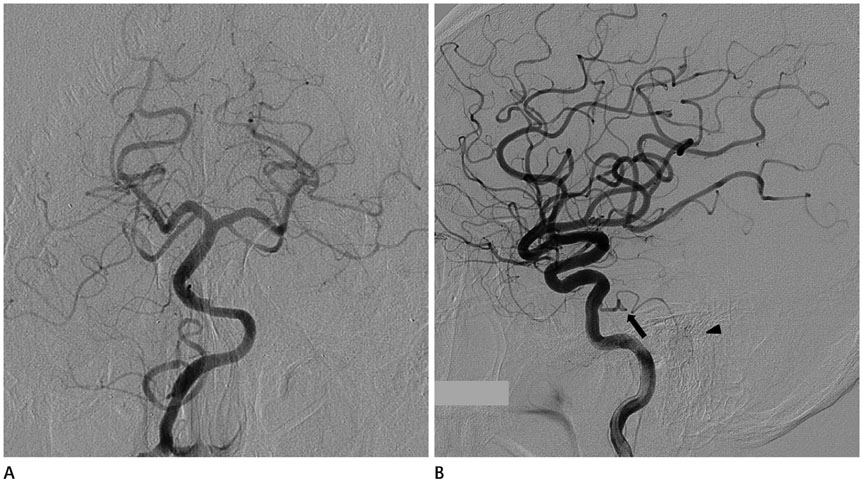J Korean Soc Radiol.
2016 Oct;75(4):309-312. 10.3348/jksr.2016.75.4.309.
Variations of Persistent Trigeminal Artery Terminating in the Anterior Inferior Cerebellar Artery: A Case Report
- Affiliations
-
- 1Department of Radiology, Inje University College of Medicine, Ilsan Paik Hospital, Goyang, Korea. sunny-cocktail@hanmail.net
- KMID: 2353683
- DOI: http://doi.org/10.3348/jksr.2016.75.4.309
Abstract
- Persistent trigeminal artery (PTA) is a rare condition that represents a remnant fetal anastomosis between the carotid artery and basilar artery. PTA typically arises from precavernous portion of the internal carotid artery (ICA) to the basilar artery. Variations of PTA extending from the ICA and directly terminating as cerebellar arteries without jointing basilar artery are particularly rare. We presented the extremely rare case of the variations of PTA, which directly terminate in the ipsilateral anterior inferior cerebellar artery. In addition, we reviewed the embryogenesis and clinical implication of this anomaly.
MeSH Terms
Figure
Reference
-
1. George AE, Lin JP, Morantz RA. Intracranial aneurysm on a persistent primitive trigeminal artery. Case report. J Neurosurg. 1971; 35:601–604.2. Siqueira M, Piske R, Ono M, Marino Júnior R. Cerebellar arteries originating from the internal carotid artery. AJNR Am J Neuroradiol. 1993; 14:1229–1235.3. Samaniego EA, Dabus G, Andreone V, Linfante I. Rare anatomical variations of persistent trigeminal artery in two patients with non-aneurysmal subarachnoid hemorrhage. J Neurointerv Surg. 2011; 3:282–284.4. Padget D. The development of the cranial arteries in the human embryo. Contrib Embryol. 1948; 32:205–261.5. Park SI, Kim DI, Jun P, Yoon PH, Hwang GJ, Cheon YJ, et al. Persistent carotid-vertebrobasilar anastomosis: radiologic findings. J Korean Radiol Soc. 1998; 39:863–867.6. Haughton VM, Rosenbaum AE, Pearce J. Internal carotid artery origins of the inferior cerebellar arteries. AJR Am J Roentgenol. 1978; 130:1191–1192.7. Lasjaunias P, Berenstein A. The vertebrobasilar system. In : Lasjaunias P, Berenstein A, editors. Functional vascular anatomy of brain, spinal cord and spine. Berlin: Springer;1987. p. 199–207.8. Saltzman GF. Patent primitive trigeminal artery studied by cerebral angiography. Acta Radiol. 1959; 51:329–336.9. Ali S, Radaideh MM, Shaibani A, Russell EJ, Walker MT. Persistent trigeminal artery terminating in the posterior inferior cerebellar artery: case report. Neurosurgery. 2008; 62:E746–E748.10. Uchino A, Kato A, Takase Y, Kudo S. Persistent trigeminal artery variants detected by MR angiography. Eur Radiol. 2000; 10:1801–1804.
- Full Text Links
- Actions
-
Cited
- CITED
-
- Close
- Share
- Similar articles
-
- Persistent Trigeminal Artery Variant Terminating in the Ipsilateral Superior Cerebellar Artery
- Persistent Trigeminal Artery with a Cerebellar Branch and Trigeminal-Cavernous Fistula from Ruptured Aneurysm: Transarterial Coil Embolization
- Persistent Primitive Trigeminal Artery Aneurysm: A Case Report
- The Clinical Analysis of 75 Patients which were Operated on MVD
- A Case bilateral Persistent Primitive Trigeminal Artery Combined with Cerebral Rete Mirabile



